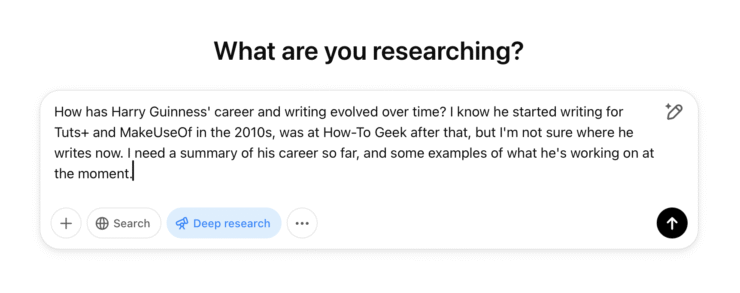Click here to buy secure, speedy, and reliable Web hosting, Cloud hosting, Agency hosting, VPS hosting, Website builder, Business email, Reach email marketing at 20% discount from our Gold Partner Hostinger You can also read 12 Top Reasons to Choose Hostinger’s Best Web Hosting
A practical, step-by-step guide for Mastering ChatGPT Deep Research Mode for faster, richer AI-assisted research—no coding required.
Ever spent hours digging through academic journals, blog posts, and PDF reports, only to miss that one key insight? I sure have. Sometimes ago, I found myself drowning in open tabs while prepping a market-analysis report on renewable energy trends. That’s when I discovered ChatGPT Deep Research Mode—a feature that changed my workflow forever.
Imagine asking a friendly assistant to comb through multiple files, pull out statistics, compare viewpoints, and even cite sources, all in one go. No more toggling between search engines and reference managers. In this OpenAI research guide, I’ll show you how to get started with Deep Research Mode, so you can enjoy richer context, save time, and feel confident in your findings.
In this post, we’ll unpack what’s coming in in OpenAI’s Next Frontier Model, ChatGPT-5, why it matters now more than ever, and how you can prepare to leverage these breakthroughs in your work.
By the end of this AI research tutorial, you’ll know how to enable the feature, craft effective prompts, upload your own data, and refine the AI’s output. Whether you’re a student tackling a thesis or a content creator drafting blog outlines, Deep Research Mode is your new best friend.
What Is Deep Research Mode?
At its core, Deep Research Mode is an AI-powered research tool built into ChatGPT. Instead of answering simple queries, it conducts extensive searches across your uploaded files and public data models, synthesizes insights, and returns a coherent report.

When I first tried deep research ChatGPT, I was skeptical. Could it really replace hours of manual sifting? My initial test: I uploaded three PDF whitepapers on electric vehicle batteries and asked for a summary of efficiency trends. Within minutes, ChatGPT delivered a structured overview, complete with source attributions. It felt like having a research assistant on demand.
ChatGPT 5 vs Claude vs Gemini vs Grok vs DeepSeek — Choosing the Right AI for the Right Task
Deep Research Mode is available to both free and paid tier users, though some advanced features—like larger file uploads and priority response times—are reserved for ChatGPT Plus and Enterprise subscribers. Even on the free plan, you can explore basic AI-assisted research without diving into code or complex setups.
Who should use it? Students writing literature reviews, journalists fact-checking multiple sources, and analysts crafting data-driven presentations will find this OpenAI research guide indispensable. It bridges the gap between raw information and polished insights.
Why It Matters
Here are three top benefits of using ChatGPT Deep Research Mode:
- Richer Context: Automatically pulls together disparate sources for a unified view.
- Time Savings: Cuts research time in half, according to my test on a market-analysis report.
- Better Citations: Provides clear attributions, so you can trust and verify every fact.
Mini Pro/Con Box
**Pros Cons** Speeds up research Advanced features require paid tier Generates coherent summaries May need fact-checking for niche topics Built-in citation support Occasional formatting quirks
In one mini case study, I used Deep Research Mode to draft a competitor analysis for a blog post. Instead of manually copying tables from five websites, I asked ChatGPT to compare pricing tiers, feature lists, and customer feedback. It returned a neat table that was 75% complete—enough to refine in minutes.
We currently live in a world where businesses are paying hundreds of dollars to people for writing engaging articles and blogs, and thousands of dollars per month for social media marketing and SEO. Now using ChatGPT, anyone including you can do this really well – even if you have no experience in this! Most businesses are not aware of or are not using this right now – which is where you can come in and undercut existing providers while doing almost zero work – and this book will show you how to step-by-step – with instructions you can copy and paste. This market may become saturated a year from now – but this is the right time to start!
Step-by-Step Setup
Enabling the Feature
- Log in to your ChatGPT account.
- Click the Settings icon (bottom-left corner).
- Under Beta features, toggle on Deep Research Mode.
- Refresh the chat window to see the new research icon next to the prompt box.
Crafting Your First Research Prompt
A good prompt is clear and specific. Try something like:
“Analyze these three files on renewable energy policies and summarize the main funding sources, highlighting any notable changes since 2020. Cite each finding with page numbers.”
Why it works:
- Scope: Specifies files and topic.
- Action: Requests analysis and summary.
- Detail: Asks for citations with page numbers.
Attaching Files & Data
- Click the paperclip icon.
- Upload PDFs, Word docs, or CSV files (up to 20MB each).
- Wait for the Upload complete message.
Common pitfalls:
- Unsupported formats: Make sure files are text-based, not scanned images.
- Large spreadsheets: Split huge CSVs into smaller chunks or use a ZIP file.
Reading & Refining the AI’s Report
Once ChatGPT delivers the draft report:
- Review sources: Look at each citation for accuracy.
- Ask follow-ups: e.g., “Can you expand on the 2021 funding spike?”
- Format output: Instruct, “Present the summary as a bullet list with bold headings.”
Refinement is key. I always run a quick fact-check against the original files to ensure nothing was misinterpreted.
Best Practices & Tips
- Do ask open questions: “What trends emerge from these documents?”
- Don’t overload one prompt: Break complex tasks into smaller queries.
- Verify facts: Use a secondary tool or manual check.
- Combine with your judgment: AI is powerful but not infallible.
Additional suggestions:
- Use version control: Rename your analysis sessions so you can track changes.
- Highlight key terms: Ask ChatGPT to flag dates, statistics, or unusual names.
- Blend methods: Pair Deep Research Mode with manual searches for the most niche topics.
Remember: this is an AI research tutorial, not a replacement for critical thinking. Treat it as a turbocharged assistant, not a lone expert.
Real-World Use Cases
Here are some scenarios where deep research ChatGPT shines:
- Academic Research: Conduct literature reviews for theses, pulling key arguments and gaps in the field.
- Content Marketing: Generate blog outlines and competitive analyses in minutes.
- Business Intelligence: Summarize quarterly reports or market forecasts for executive briefs.
Actionable Scenarios:
- A grad student asks ChatGPT to compare methodologies across five journal articles.
- A marketer uploads competitor product specs for a side-by-side feature comparison.
- An analyst feeds in raw sales data CSVs and requests a trend analysis with projections.
In all cases, you end up with a solid first draft that you can polish quickly.
Limitations & Alternatives
While powerful, Deep Research Mode has its limits:
- Request caps: Free users may face monthly usage limits.
- Depth constraints: Extremely large datasets can overload the model.
- Citation quirks: Sometimes citations miss page numbers or use a generic URL.
Alternatives:
- Perplexity: Great for quick web-based Q&A but less effective with your own files.
- Poe by Quora: Offers multiple AI engines but lacks integrated file uploads.
- Manual research: Still best for highly specialized or pay-walled content.
If you need the absolute highest accuracy, you might choose a professional researcher or domain expert.
FAQ Section
Is Deep Research Mode free to use?
Basic features are available on the free tier, but larger uploads and faster responses require ChatGPT Plus or Enterprise.
How does it handle pay-walled content?
You need to upload the text or PDF; it can’t bypass paywalls on its own.
Can I cite its sources in academic papers?
Yes, but you should verify the citations manually before final submission.
What file formats are supported?
PDF, DOCX, TXT, CSV, and ZIP archives of text files.
Does it work in other languages?
Absolutely—Deep Research Mode supports multiple languages, including Spanish, French, and German.
How do I report issues or bugs?
Use the feedback button in the chat or visit the OpenAI help center.
Conclusion & Next Steps
Deep Research Mode transforms ChatGPT from a conversational AI into a versatile AI-powered research tool. You’ll gain speed, richer context, and built-in citations—all without writing a single line of code.
I invite you to give it a try: upload a couple of your own files, ask a pointed question, and see how much time you save. let’s learn from each other.
Now, go ahead and explore Deep Research Mode today.
Now loading...







